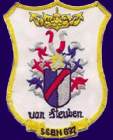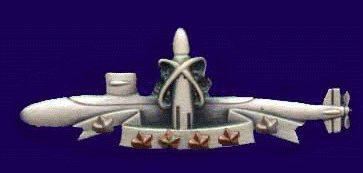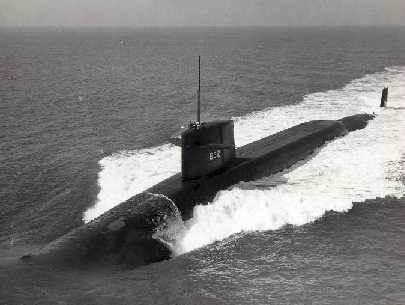





BARON VON STEUBEN
Friedrich Wilhelm Ludolf Gerhard Augustin von Steuben was born sometime in 1730 in Magdeburg in the Electorate of Brandenburg. The son of a lieutenant of engineers in the army of Frederick William I, King of Prussia and Elector of Brandenburg, he spent his early childhood in Russia where his father had entered the service of Czarina Anne at the command of Frederick William I. After the accession of Frederick II to the Prussian throne, von Steuben returned to Germany with his father in 1740.
In 1747, at age 17, he became a cadet in a Prussian infantry regiment and, two years later, received his patent (commission) as an ensign. Von Steuben served with distinction during the Seven Years� War. His specific training and experience in general staff duties equipped him for his later role in the American Revolution.
His discharge from the army for obscure reasons in 1763 and subsequent financial difficulties caused him to seek service with the American Army in 1777. Stating that he wished no immediate compensation and would stake his fortunes upon the success of the Revolution, von Steuben reported to General Washington at Valley Forge in February 1778.
He was almost immediately successful in the training of the Continental Army in accordance with the exacting standards of the Prussian Army. Thereafter, the Continental Army proved itself, battalion for battalion, the equal in discipline of the best British regulars. He served with distinction with General Nathanael Greene in the Carolinas in 1780 and with General Lafayette at Yorktown in 1781.
Von Steuben became a citizen of the United States in 1783 and, following retirement from the army, resided in New York where he became one of the most popular figures in the city until his death in 1794.
Dictionary of American Naval Fighting Ships,
(1981) Vol. 7, pp.560-561, 563.
USS VON STEUBEN
The original USS von Steuben began life as a german passenger ship, the Kronprinz Wilhelm. She was interned in Newport News, VA, by the US Government upon our entry to WWI. She was then converted to a troop transport, repainted, and renamed--about 45 years before the second USS von Steuben began life at Newport News. The first USS von Steuben was scrapped in Baltimore, MD, in 1923.
The first photo (below) shows the ship as a German passenger liner. The second and third photos show the ship in early and late WWI camouflage schemes.
This last photo is of the first Von Steuben after a collision with its sister ship, the Kaiser Wilhelm II (renamed the Agamemnon, and also interned by the US government for use as a troopship). Name something the Von Steuben and there's a good chance that it's gonna bump into something, I guess...
Displacement: Surfaced: 7,280 t. Submerged: 8,250 t. Length: 425� Beam: 33� Draft: 32� Speed: 20+ k. Complement: 110 Armament: 16 Polaris missiles; 4 21" torpedo tubes Class: LAFAYETTE USS VON STEUBEN, SSBN 632
The second VON STEUBEN (SSBN-632) was laid down on 4 September 1962 at Newport News, Va., by the Newport News Shipbuilding & Dry Dock Co.; launched on 18 October 1963; sponsored by Mrs. Fred Korth; and commissioned on 30 September 1964, Comdr. John P. Wise (blue crew) and Comdr. Jeffrey C. Metzel (gold crew) in command.
During the fall of 1964, the fleet ballistic missile submarine completed two shakedown cruises--one for each crew--and a period of antisubmarine warfare (ASW) training between the two. On 22 December, the submarine's gold crew fired her first Polaris missile on the Atlantic missile range before returning to Newport News for Christmas. She changed crews again at the beginning of the new year, 1965, and returned to the missile range off Cape Canaveral (then called Cape Kennedy) where the blue crew fired its first missile. In February, after completing all initial training operations, she returned to Newport News.
In March, VON STEUBEN headed for her first duty assignment. The submarine joined Submarine Squadron (SubRon) 18 at Charleston, S.C., her new base of operations, and immediately began conducting classified deterrent patrols. Her primary mission was and is to deter aggression by providing a highly-mobile launch platform for her nuclear warhead-bearing Polaris missiles. Since her security and mission would be impaired should any potential enemy learn of her patrol route and activities, that information is highly classified and cannot be recounted here. However, she has conducted more than 30 such patrols since her commissioning, at the rate of four or five per year.
At the end of her 11th patrol early in 1968, VON STEUBEN was reassigned to SubRon 16 and operated out of Rota, Spain, until the middle of 1969. During that assignment, she visited Groton, Conn., in the summer of 1968 for repairs at the Electric Boat Division of General Dynamics Corp., after which she resumed deterrent patrols out of Rota. In November 1970, she visited Groton once again, this time near the end of a 16-month overhaul during which she was modified to carry the newly developed Poseidon C-3 missile. She conducted post-conversion shakedown during the early months of 1971 and fired her first and second Poseidon missiles in February and March, respectively. She returned to Charleston and resumed deterrent patrols in May 1971. Since that time, she continued to make patrols out of Charleston and, recently, also from the submarine base at Holy Loch in Scotland.
Dictionary of American Naval Fighting Ships,
(1981) Vol. 7, pp.560-561, 563.
Placed "in commission, in reserve" on 7 July 1993, VON STEUBEN was both decommissioned and stricken from the Naval Vessel Register on 26 February 1994. As of May 1999, she was in storage at Bremerton, Washington awaiting her turn to enter the Navy�s Nuclear Powered Ship and Submarine Recycling Program. Her start date had not yet been determined. When she emerges from the program, she will no longer exist as a complete ship and will be classed as scrapped.
Naval Institute Proceedings
May 1999, p.180.
Additional information can be found in a ship's pamphlet published about 1967. To view that pamphlet, CLICK HERE. Your Web browser will need to be configured to display Acrobat PDF files in order to view this document, and it may take a couple of minutes to load.
Launch photo thanks to TMC Robert F. Marble. Other photos contributed by various anonymous sources. Von Steuben pamphlet contributed by MM2 Joe McCoy.
Click on the boat to return to the SSBN 632 home page...
